If you have one day in Nagasaki, Japan, you’ll get an awesome introduction to the capital of the Nagasaki Prefecture in Kyushu Island. Whether you’re visiting Nagasaki (長崎) as a day trip from Fukuoka or spending the full day here, Nagasaki is a unique place to explore due to its history and Western-inspired architecture.
Nagasaki is known as the second location for the atomic bomb attack on August 9, 1945. We were interested in seeing the differences in learning about the Hiroshima incident. What you may not have known is that Nagasaki was also famous for its trade and port usage with the Portuguese and Dutch during the 16th and 19th centuries. During this time, the rise of Christianity occurred which is why this city has many cathedrals.
With this 1 day Nagasaki itinerary, we share the best of Nagasaki with the top things to do in Nagasaki in one day, how to get around Nagasaki, what to eat, and other insider tips to help with your planning.
Read more to learn about what to see and do in Nagasaki!
Need ideas on where to go in Japan? Check out our post below for inspiration:
- Explore Beppu in Oita
- Dazaifu day trip from Fukuoka
- Miyajima Island
- Naoshima Island
- Okayama
- Fun things to do in Tokyo
*Disclaimer: Traveling to Japan? Please note that this post contains affiliate links. If you click on them and make a purchase, we receive a small commission. There is no additional cost to you. Appreciate the support.
How Long Should You Stay in Nagasaki?
This itinerary highlights one full day to spend in Nagasaki. Although we saw the main tourist attractions and focused on the atomic bomb history, we would have loved to stay longer to explore more of the history of the European influences seeing the churches and architecture.
If you have additional time in your Kyushu itinerary, spend at least 2 days in Nagasaki. There are exciting day trips from Nagasaki that you can take which we’ll share more below.
How to Get to Nagasaki
Using the Japan Rail (JR) pass? This will be the perfect opportunity to use the JR pass as you travel across Japan. We love riding the shinkansen high-speed train since it’s convenient and has comfortable seats. You can purchase a wide-area JR pass with access throughout the entire country. You can use a JR Kyushu pass for the Kyushu area but shinkansen usage is limited. Either option is recommended depending on how much time you’ll spend traveling.
Buy your JR wide-area pass here and save money! Or, buy the JR Kyushu pass here for a discounted price!
From Fukuoka to Nagasaki
Take the shinkansen train from Fukuoka’s Hakata Station (博多駅) to Nagasaki Station (長崎駅). It’ll take 2 hours and 10 minutes.
From Osaka to Nagasaki
While it may seem tempting to go to Nagasaki as a day trip from Osaka, we would advise against it. It’ll take a long time to get there by the shinkansen – over 4.5 hours one-way! It’s better if you’re coming from Fukuoka, Hiroshima, or somewhere closer to reduce your travel times.
Here is the route if you’re interested:
From Osaka Station (大阪駅), take the local Tokaido-Sanyo line to Shin-Osaka Station (新大阪駅). Transfer to the shinkansen lines at Shin-Osaka Station to Shin-Tosu Station (新鳥栖駅). This will take 3 hours. From Shin-Tosu Station to Nagasaki Station (長崎駅), allocate another 1.5 hours.
We recommend that you have reserve seating in advance so you don’t need to rush as much during the transfer time or try to figure out which train is for non-reserved seating.
How to Get Around Nagasaki
Streetcar
The best way to travel around Nagasaki is by using the streetcar via Nagasaki Electric Tramway Company (site is in Japanese). Four routes travel throughout the city and pass by sightseeing places such as the Atomic Bomb Museum, Chinatown, etc.
Purchase a one-day pass at your hotel, any information tourist centers, and at Nagasaki Station. You cannot buy the pass on the streetcar.
The cost is 500 yen ($4.60 USD) for junior high students to adults and 250 yen ($2.30) for elementary school students. Otherwise, each ride is 130 yen ($1.20). If you use cash, it must be an exact change for payment. You’ll need to ride the streetcar at least 4 times to break even with the cost of the pass.
It’s easy to use the streetcar. Wait at one of the stops, ride the streetcar to your destination, press the button if you want to get off at the next stop, and show the day pass to the driver.
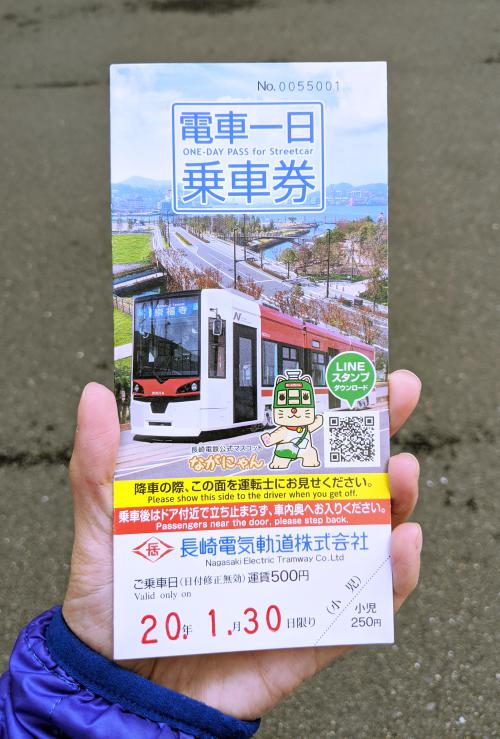
Use this one-day streetcar ticket as many times as you’d like on your Nagasaki 1 day itinerary.
Walking
Another option to travel around Nagasaki is by walking. It’s a good 35-minute walk from Nagasaki Station to the Atomic Bomb Museum. Wear comfortable walking shoes if you decide to walk around the city. We did a combination of walking and taking the streetcar.
Taking a Tour
If you prefer to take a guided tour of Nagasaki, consider this option where you get to visit the historical sites.
Map of What to See in Nagasaki
Top Things to Do In Nagasaki in One Day
With one day in Nagasaki, you’ll have a packed schedule. Once you arrive in Nagasaki, head to your accommodation to drop off your luggage if staying overnight or place large belongings in the coin-operated lockers at the Nagasaki Station. Most of the places that we’ve visited are free while some have a small admission cost fee.
1. Nagasaki Chinatown
We’re starting the day by visiting Chinatown in the Shinchi area (長崎新地中華街). This is the oldest Chinatown in Japan. (The other ones are in Yokohama and Kobe.)
The best thing to do in Chinatown is to walk around, visit shops, eat Chinese food, and see the various temples such as Kofukuji (興福寺) and Sofukuji (崇福寺). You’ll also see a red friendship gate in the area. There is an arcade shopping area, Hamano Machi Shopping Arcade, for more shopping and restaurants.
If you time your visit with the Lunar New Year, you’ll love visiting the Nagasaki Lantern Festival. It’s a two-week festival to celebrate the Chinese New Year and also the changes of the season from winter to spring. The festival dates vary every year depending on the calendar but it’s usually between January-February.
What we love about the festival is that the Nagasaki train station and the Chinatown area is decorated with gorgeous lanterns and displays. There are over 15,000 lanterns that light up throughout the day and evening. You’ll find displays of zodiac animals and historical Chinese figures. Some of the displays are over 10 meters (32.8 feet) high. We’ve been to many Chinatowns during our travels and we were impressed with the displays here!
Also, seven venues offer shows every day several times a day. During our visit, the Shinchi Chinatown Venue at Minato Park had Chinese acrobatics and lion dancing shows. The Chinese acrobats are so flexible and can balance anything from chairs to spinning plates. Visitors can watch these performances for free and give an optional donation at the end of the show.
Address: 10-13 Shinchimachi, Nagasaki, 850-0842, Japan (〒850-0842 長崎県長崎市新地町10−13)
Streetcar Stop: Shinchi Chinatown (Stop #31 on Blue Line #1 and Green Line #5)
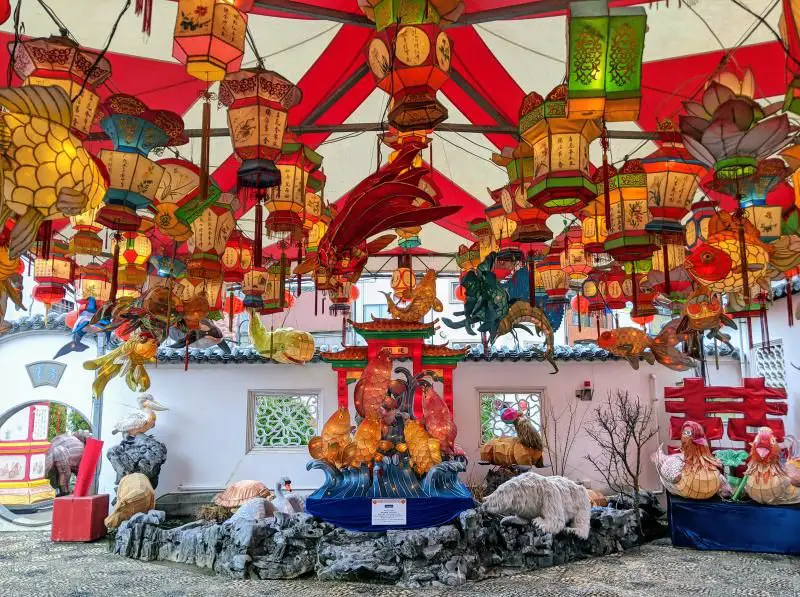
If you have a chance to visit Nagasaki during the Lantern Festival, you’ll see incredible decors and displays.
2. Meganebashi Bridge (Spectacles Bridge)
One of the things to do in Nagasaki is to visit the Meganebashi Bridge (眼鏡橋). When you look at the bridge from afar, they look like a pair of glasses. This bridge was built in 1634 so it’s the oldest arch-shaped stone bridge in Japan. You’re allowed to walk on the bridge and along the canal to see the Nakashima River up close. It’s also a fabulous place to take photos if you visit during the Lantern Festival with the lanterns everywhere.
Address: Uonomachi, Nagasaki, 850-0874, Japan (〒850-0874 長崎県長崎市魚の町)
Streetcar Stop: Meganebashi Bridge (Stop #37 on Yellow Line #4 & Green Line #5)
3. Nagasaki Atomic Bomb Museum & Nagasaki National Peace Memorial Hall for Atomic Bomb Victims
Atomic Bomb Museum
To learn more about the Nagasaki atomic bomb, a visit to the Atomic Bomb Museum (長崎原爆資料館) is a must-visit for any Nagasaki itinerary. If you’ve been to the Hiroshima Peace Memorial Museum, then this one is a nice complement to highlight the history of the Nagasaki bombing.
As mentioned earlier, this bombing occurred three days after the Hiroshima bomb on August 9, 1945, by the United States. Nagasaki was the second site used because of its success as a port city. Luckily the blast from the “Fat Man” bomb, made out of plutonium, only affected the Nagasaki city area due to the mountains.
The museum isn’t too large yet it provides the history of what led up to the use of the atomic bomb, artifacts of clothing and bottles from victims, and photos of the city before and after the bomb. Most of the buildings were burnt down. There is an interesting section that has replicas of buildings damaged in the area such as the Water Tank from Keiho Middle School and Urakami Cathedral. The museum also highlights the history of how the atomic bomb was developed.
It’s well worth the time to read through the history and hear the victims’ stories about the bombing. After visiting Hiroshima and Nagasaki’s museums, we hope countries will never use atomic bombs again. The repercussions and damages to the country and people are devastating!
There are free day lockers available if you don’t want to carry your backpack around the museum. You’ll receive your 100 yen ($.90) deposit once you return the locker key.
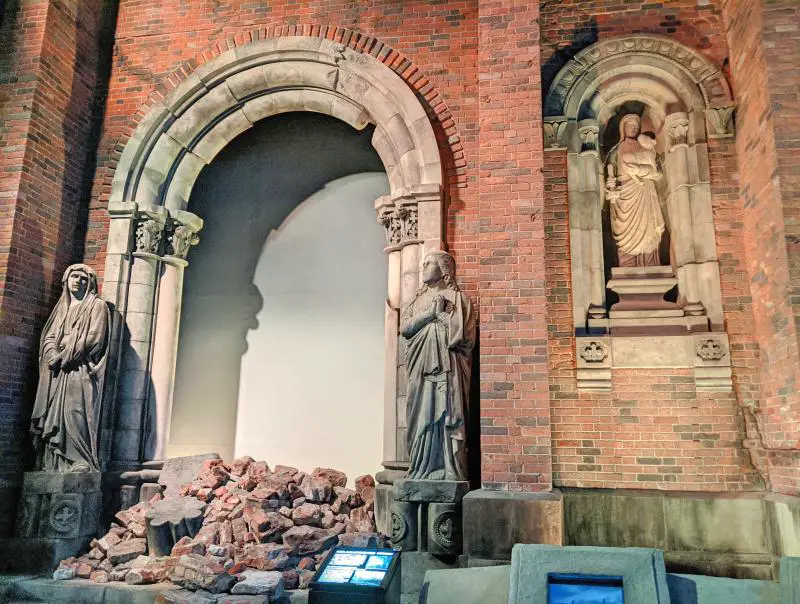
The replicas of the ruins in the Nagasaki Atomic Bomb Museum is intriguing to check out on your Nagasaki itinerary.
National Peace Memorial Hall for Atomic Bomb Victims
Connecting to the Atomic Bomb Museum is the Nagasaki National Peace Memorial Hall for Atomic Bomb Victims. Similar to the one in Hiroshima, it’s an opportunity to pay respects to those who passed during the atomic bomb incident. There are testimonials and photos of atomic bomb victims. You can also wear 3D glasses and view what it was like at the hypocenter after the bomb dropped.
On your way out, you pass by an open memorial hall where you can practice your origami skills. Origami is a Japanese craft of folding paper into creative objects. Here, you can make paper cranes with complimentary origami paper. It’s a good souvenir to remember your day at Nagasaki or you can donate your paper crane to the museum.
Address: 7-8 Hiranomachi, Nagasaki, 852-8117, Japan (〒852-8117 長崎県長崎市平野町7−8)
Opening Hours:
- Atomic Bomb Museum: 8:30am-5:30pm (April, September-March), 8:30am-6:30pm (May-August), 8:30am-8:00pm (August 7-9)
- Peace Memorial Hall: 8:30am-6:30pm (May-August), 8:30am-8:00pm (August 7-9), 8:30am-5:30pm (September-April)
Admission Cost:
- Atomic Bomb Museum: 200 yen adults, 100 yen ($.90) elementary to high school students, free under elementary school students. Audio rental fee 157 yen ($1.50)
- Peace Memorial Hall: Free
Streetcar Stop: Atomic Bomb Museum (Stop #20 on Blue Line #1 and Red Line #3)
4. Hypocenter & Nagasaki Peace Park
Hypocenter
On your way out of the museum, you’ll pass by the hypocenter at the Hypocenter Park (爆心地公園) where the atomic bomb. It’s currently a memorial site with a statue.
Address: 5 Matsuyamamachi, Nagasaki, 852-8118, Japan (〒852-8118 長崎県長崎市松山町5)
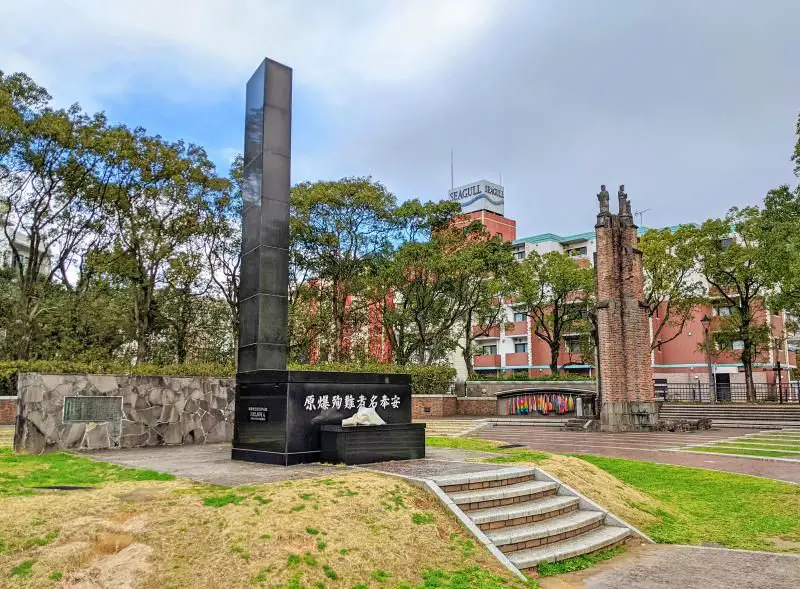
This is the hypocenter of the atomic bomb attack on August 9, 1945.
Peace Park
From there, walk about 10 minutes or take the streetcar to go to the Peace Park (平和公園). The Peace Park was built in 1955 to promote world peace. It’s a small yet peaceful area. Plus, you get a change of pace after reading the tragedies from the museum.
The Peace Park has the Peace Fountain and the Peace Statue. The Peace Fountain represents the atomic victims who passed away while searching for water. The Peace Statue is a 10 meters bronze statue that has its right hand pointing to the sky representing the threat of nuclear weapons and the left hand representing world peace. The statue’s eyes are closed to give a prayer to those who lost their lives. Next to the statue is a peace memorial with origami paper cranes strung on strings.
If you have time, you can walk 15-minutes to the Urakami Cathedral from Peace Park. It’s a Roman Catholic church that was destroyed by the atomic bomb and rebuilt on the original site.
Address: 9 Matsuyamamachi, Nagasaki, 852-8118, Japan (〒852-8118 長崎県長崎市松山町9)
Streetcar Stop: Peace Park (Stop #19 on Blue Line #1 and Red Line #3)
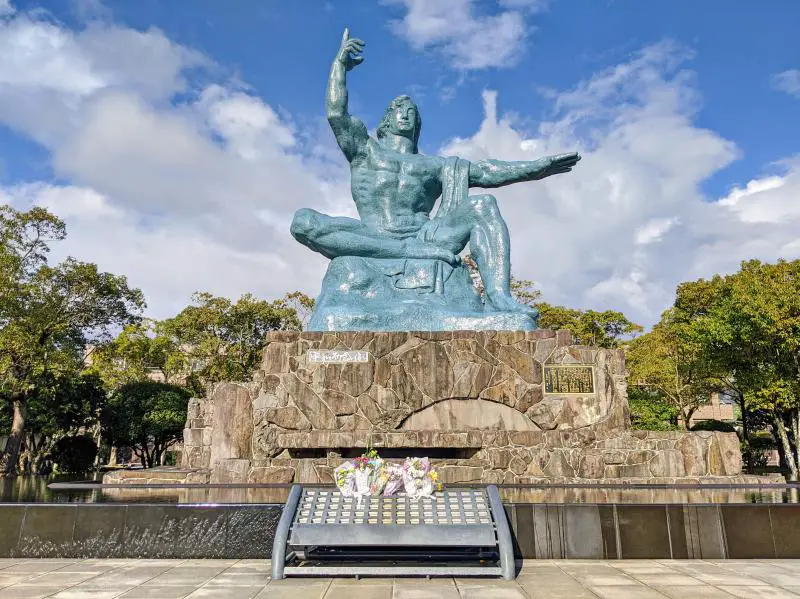
The Peace Statue at the Peace Park is a lovely place to visit in Nagasaki.
5. Sanno Shrine Second Torii Gate
At the Atomic Bomb Museum, we saw that there was a Sanno Shrine that only has one leg (山王神社 (一本柱鳥居)). The site was 900 meters (.56 miles) from the hypocenter and somehow managed to stay up with one leg after the blast occurred. You’ll see the remains of the other leg on the ground. To see this torii gate, you’ll need to climb up a set of stairs.
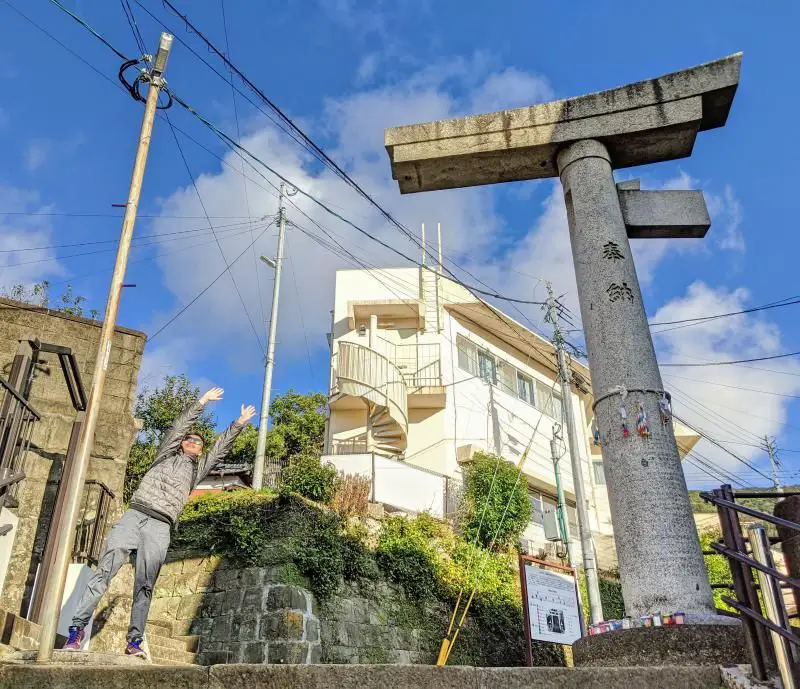
It’s incredible that the Sanno Shrine Torii gate withstood the atomic bomb and is still standing today!
Afterward, walk around the corner to see the nearby Sanno Shrine. It’s a small temple but the main attraction is seeing the two large camphor trees at the entrance. The trees survived the atomic bomb blast and were thought to be dead. However, they continued to survive and even grew larger than before. Now, they are recognized as natural monuments in the city.
Address: 2 Chome-6-56 Sakamoto, Nagasaki, 852-8102, Japan (〒852-8102 長崎県長崎市坂本2丁目6−56)
Streetcar Stop: University Hospital (Stop #21 on Blue Line #1 and Red Line #3)
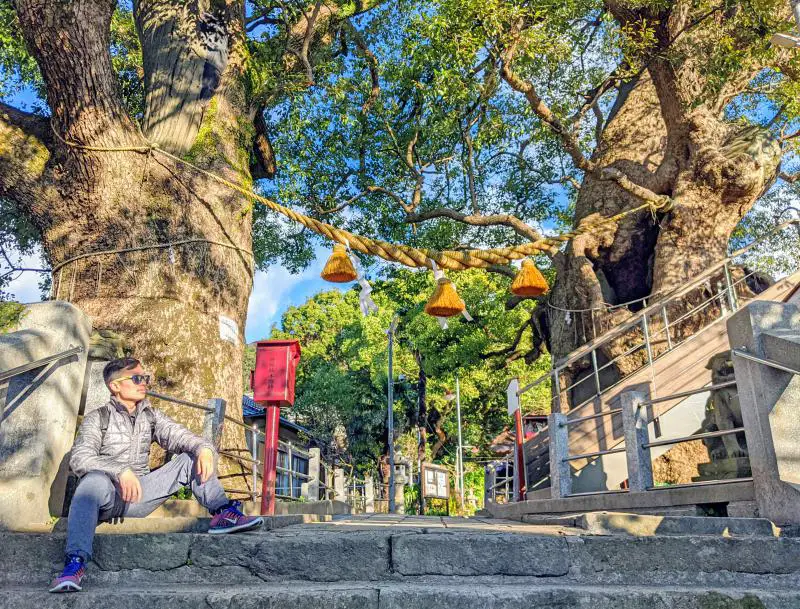
The camphor trees at Sanno Shrine continue to thrive after the atomic bomb incident.
6. Mount Inasa
Want to see the city of Nagasaki from above? Head to Mount Inasa (稲佐山). This place was one of the highlights of our trip since the Mount Inasa Observatory Tower is 333 meters (1,093 feet) above sea level.
The best time to visit Mount Inasa is at sunset when you see the city light up for the evening. For us, the city got dark between 6:15pm-6:20pm and it was a gorgeous sight! According to the signage, this view of the city and the port is considered one of the “World’s top three night views.” The other two are Monaco and Hong Kong.
If you decide to take photos at sunset, it’s recommended to visit 10 minutes before sunset to stay in your certain spot. As a warning, it’s super windy and blistering cold outside the observatory deck so you’ll need a jacket and gloves. Otherwise, you can view the city inside the observatory deck where you won’t need to worry about the cold weather.
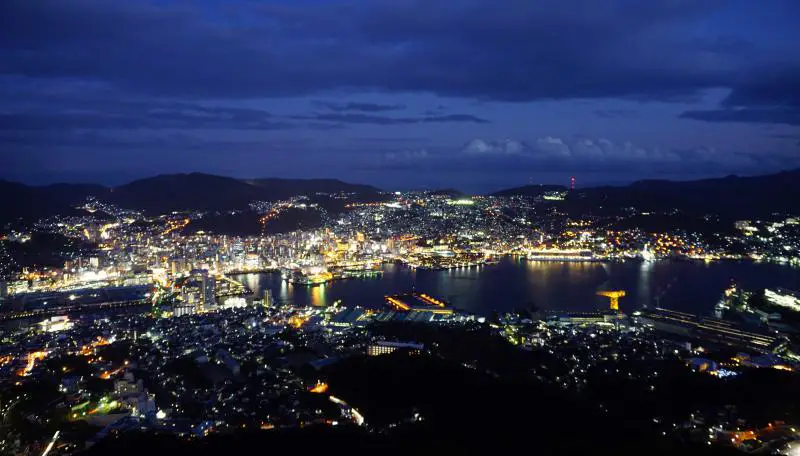
The evening view is gorgeous from the Mount Inasa summit and a fabulous way to end your one day in Nagasaki.
To get to this observatory tower, you can either walk, drive, or take the ropeway (cable car). We’ll share more information below.
Address: Ohamamachi, Nagasaki, 850-0066, Japan (〒850-0066 長崎県長崎市大浜町)
Opening Hours:
- Mount Inasa Observation Deck: 8:00am-10:00pm
- Ropeway: 9:00am-10:00pm
Admission Cost:
- Mount Inasa Observation Deck: Free
- Mount Inasa Ropeway: 1,230 yen ($11.40) round-trip for adults
How to Get There
- Take the ropeway.
Take the streetcar to Takaramachi (Stop #25 on Blue Line #1 and Red Line #3 ) and cross the Inasa-bashi Bridge. Find the Fuchi Shrine (淵神社) and take the ropeway from there.
Address of Fuchi Shrine: 8-1 Fuchimachi, Nagasaki, 852-8012, Japan (〒852-8012 長崎県長崎市淵町8−1)
- Walk to Mount Inasa
If you have more time and want to get some exercise, consider taking a walk up to Mount Inasa. It’s a peaceful walk through the residential area and the mountain. You’ll need over an hour to get to the top of the mountain.
Tip: It’s recommended that you map the walking directions on Google Maps app since the walking trail isn’t marked.
Depending on your starting point, you can go through the residential area up the mountain if coming from the Takaramachi streetcar stop.
We crossed the Yanagawa-bashi Bridge when coming from the Mori-machi streetcar stop (Stop #23) and walked up and around the mountain. It’s not the usual walking route since we didn’t see any other walkers and some parts didn’t have sidewalks. On the way back down, we took the walking route through the residential area which was faster.
For 2+ Days in Nagasaki, Add These Attractions
If you have an extra day or two in Nagasaki, there are plenty of attractions to visit. We would love to return to Nagasaki to visit these other sites and learn more about how Christianity made an impact in Nagasaki’s history.
Glover Garden
Glover Garden (グラバー園) is a historical landmark that was built by Thomas Blake Glover, a Scottish merchant. This garden area is on a hillside and has beautiful Western houses with Japanese influences. Currently, there are 9 houses that you can look through. You can also see the Nagasaki port from the area.
Address: 8-1 Minamiyamatemachi, Nagasaki, 850-0931, Japan (〒850-0931 長崎県長崎市南山手町8−1)
Opening Hours: 8:00am-6:00pm
Admission Cost: 620 yen ($5.75) adults, 310 yen ($2.90) high school students, 180 yen ($1.70) elementary and junior high students
Streetcar Stop: Oura Cathedral (Stop #50 on Green Line #5)
Oura Church
If you’re interested to learn about Christianity in Nagasaki, check out the Oura Church (大浦天主堂). This place is considered one of the UNESCO World Heritage Sites for its Outstanding Universal Value as a “Hidden Christian Site.” During the 17th to 19th centuries, Christianity was banned in Japan so practitioners had to practice in secret. The ban was lifted in 1873.
It’s right across from the Glover Garden. There is an on-site museum. Visitors state that you’re not allowed to take photos inside the cathedral even though there are beautiful stained glass windows inside.
Address: 8-1 Minamiyamatemachi, Nagasaki, 850-0931, Japan (〒850-0931 長崎県長崎市南山手町8−1)
Opening Hours: 8:00am-6:00pm
Admission Cost: 1,000 yen ($9.30) adults, 400 yen ($3.70) junior high and high school students, 300 yen ($2.80) elementary school students
Streetcar Stop: Oura Cathedral (Stop #50 on Green Line #5)
Dejima
Located close to the Chinatown, Dejima (出島) is a man-made island that was specifically used for trade with Dutch merchants. It was built in 1638 and then ceased operations for trade when Nagasaki’s ports were developed in 1904. Currently, it’s a restored area where visitors can see traditional houses and learn about Nagasaki’s history and the importance of trading with the Dutch.
Address: 6-1 Dejimamachi, Nagasaki, 850-0862, Japan (〒850-0862 長崎県長崎市出島町6−1)
Opening Hours: 8:00am-9:00pm
Admission Cost: 520 yen adults, 200 yen high school students, 100 yen elementary and junior high students
Streetcar Stop: Dejima (Stop #30 on Blue Line #1)
Hashima Island (Gunkanjima or Battleship Island)
One of the unique places to visit in Nagasaki is Hashima Island (端島, also known as Gunkanjima and Battleship Island). It’s an abandoned island that used to do undersea coal mining from 1887-1974 so you’ll see untouched and abandoned sites. For those who love seeing hidden gems, then this place is for you! Heads up that there is some controversy with the island as they used forced labor from Korea and China to build the island.
Currently, this place is open to tourists. Visitors must visit the island on a tour due to safety.
Click here and check out this tour option.
Huis Ten Bosch
Located in the Sasebo area of Nagasaki, Huis Ten Bosch (ハウステンボス) is an outdoor theme park that is a replica of the Netherlands. You see replicas of traditional Dutch buildings, windmills, and seasonal plants. There are also amusement park rides and the chance to see a real-life Dutch ship. This is a great opportunity to travel to the “Netherlands” while you’re still in Japan.
Address: 1-1 Huis Ten Bosch Machi, Sasebo, Nagasaki 859-3292, Japan (〒859-3292 長崎県佐世保市ハウステンボス町1-1)
Opening Hours: 9:00am-9:00pm (Check the schedule as the closing time varies.)
Admission Cost: 7,000 yen ($64.85) adults (18+ years), 6,000 yen ($55.60) junior high to high school students, 4,600 yen ($42.60) elementary school students, 3,500 yen ($32.40) children under 2+ years
Save money with discounted tickets to Hui Ten Bosch here.
How to Get There: From Nagasaki Station, take the rapid Sasebo Line and get off of Huis Ten Bosch Station. It’ll take 1.5 hours one-way.
What to Eat in Nagasaki
Champon & Sara-Udon
The best thing to eat in Nagasaki is champon and sara-udon! Champon is one of the delicious Japanese foods to try. It originated in Nagasaki and it’s a noodle soup with beef, seafood, bean sprouts, cabbage, and naruto (swirl) or kamaboko (pink and white) fish cakes. The soup is made out of chicken and pork. Sara-udon is a plate of fried thin noodles with the same toppings as in the champon and topped with a sauce. It’s similar to the Cantonese style fried noodle dish.
The originator or Nagasaki Champon is at the restaurant, Shikairou (四海樓), in the Chinatown area. Established in 1899, this place is popular to try this specialty dish. You can also order other Chinese food here.
Address: 4-5 Matsugaemachi, Nagasaki, 850-0921, Japan (〒850-0921 長崎県長崎市松が枝町4−5)
If you want to try another place, head to Ringer Hut! You heard that right – the international chain restaurant that serves champon! Opened in 1974, Ringer Hut has over 470 restaurants in Japan and many locations internationally. My first exposure to Ringer Hut was when my dad took us to eat Ringer Hut in San Jose, California during our childhood.
During our visit, we ordered one champon with a free noodle upgrade and one sara-udon. Since we came during lunchtime, lunch specials include gyozas. It’s been years since we’ve had Ringer Hut and the champon and sara-udon were delicious! Loved the flavor of the champon soup and the amount of cabbage and toppings. The sara-udon was heavenly as the crispy noodles didn’t become soggy after 15 to 20 minutes of eating.
Eating at Ringer Hut is affordable and you’ll have consistent flavors. Dishes are around 600-1,000 yen ($5.60-$9.30) depending on the size of your bowl. (As a side note, we also found Ringer Hut in Ho Chi Minh City, Vietnam! Since we’re living in Ho Chi Minh City, we were excited to see this restaurant here).
Address: There are 10 locations in Nagasaki City. We went to the one in Dejima area (1-5 Dejimamachi, Nagasaki, 850-0862, Japan/〒850-0862 長崎県長崎市出島町1−5)
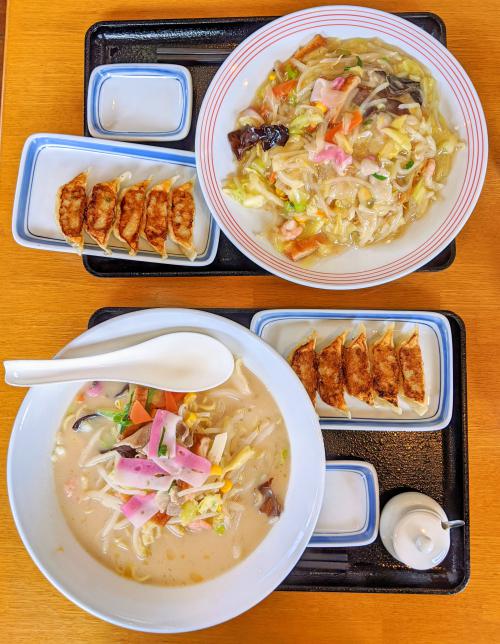
The champon and sara-udon at Ringer Hut don’t disappoint the taste buds.
Sushi
If you want to have a conveyor belt sushi restaurant, we recommend Wakatake Maru (若竹丸 浜町店). It’s on the second level in the Hamano-machi Arcade Shopping Arcade.
We had it for dinner and it was one of the better conveyor belt sushi places that we’ve had. There is a variety of sushi that you can order. If you don’t want to have full-size nigiri pieces, you can get adorable mini-size pieces (they are just regular size cut in half).
You get to order off a tablet and have your sushi delivered to you. There aren’t any special colored plates as the tablet keeps track of your order. You may want to double-check your receipt to make sure that you received everything.
Address: 1-10 Hamamachi, Nagasaki, 850-0853, Japan (〒850-0853 長崎県長崎市浜町1−10)
Opening Hours: 11:00am-9:30pm (last order is 9:20pm)
Where to Stay in Nagasaki
Nagasaki has a variety of places to stay overnight depending on your budget. It doesn’t matter where you stay as long as you’re within walking distance to the streetcar stop.
Click here to read reviews of Nagasaki accommodations and make a reservation here.
We stayed at MP Hotel Nagasaki Mizubenomori. Located south of Nagasaki Station and close to Glover Garden, it’s an apartment hotel in a quiet, residential area. We loved this place as our small apartment came with a comfortable bunk bed (a double bed is also available), separate shower and toilet rooms, mini-refrigerator, electric kettle, and a washing machine. You can get clips and one packet of complimentary laundry detergent from reception. The washing machine was a huge help after our week of travels. This place has an elevator if you have heavy luggage. The cost of the room is $75 per night for 2 person occupancy.
Reserve a room at MP Hotel Nagasaki Mizubenomori here.
Here are other Nagasaki accommodations to consider:
Hotel Forza – If you want to be in the heart of Chinatown, then stay at Hotel Forza. Guests enjoy the location as it’s close to restaurants and shopping. The cost of a room is $115-$140 per night for 2 person occupancy.
Make a reservation for Hotel Forza today!
JR Kyushu Hotel – Traveled a long distance to get to Nagasaki? Stay at the JR Kyushu Hotel which connects to the Nagasaki Station. Guests enjoy the convenience to the Amu Plaza Shopping Center and the spacious rooms. The cost of a room is $115-$280 per night for 2 person occupancy.
Reserve a room at JR Kyushu Hotel here.
We hope you enjoyed your 1 day in Nagasaki as much as we did! It’s a unique city to visit in Japan with its European influences and history. Plus, you get to learn about the second atomic bomb incident.
Want to visit Nagasaki? If so, what would you like to see? If you have questions about this place, please leave a comment below.
Like this post? Save it to your Japan Pinterest board.
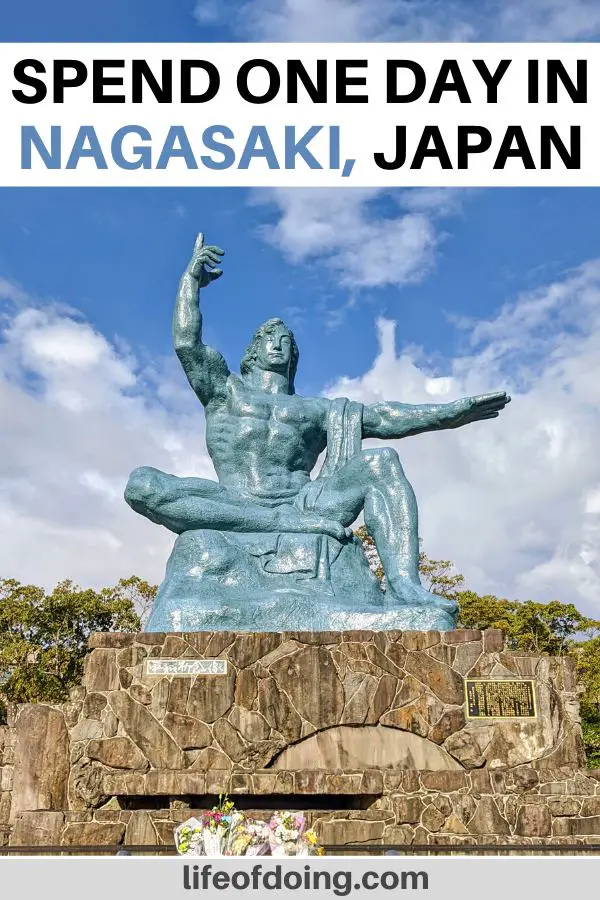 |


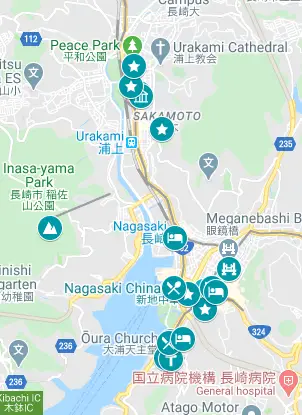
2 comments
I lived in Japan for 2 1/2 years as a pre-teen but never got to explore that far south. Sounds like there are a lot of interesting sights here. I love using alternate methods of travel so the streetcar would probably be my choice for seeing the area – although I do enjoy walking tours as well. Seeing the city from above would be a welcome sight after the sadness of the museums. I too hope no one ever again uses an atomic bomb.
Hi Ava. Have you been back to Japan recently? Would love to hear about your experiences living in Japan when you were younger versus traveling there in the present days. Hope you get a chance to visit Nagasaki in the future!